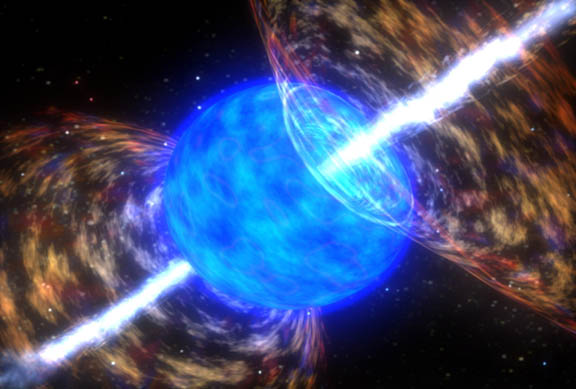2015/04/10
A new study provides detailed insight into the most powerful explosions in the universe: gamma-ray bursts. The simulation explains the modes of particle acceleration in these rare events better than previous models and can explain conflicting astrophysical observations. Scientists from DESY and two US universites present their work in the journal Nature Communications.
Gamma-ray bursts happen when extremely massive stars go supernova. These explosions can be seen nearly across the whole visible universe, up to several billion lightyears. The giant stars' strong magnetic fields channel most of the explosion's energy into two powerful jets of electrically charged gas (plasma), one at each magnetic pole. These plasma jets are powerful natural particle accelerators.
Scientists expect the plasma jets to be a significant source of cosmic rays, high-energy subatomic particles (mostly protons) that constantly pepper Earth's atmosphere from space. These particles can have up to ten million times the energy of the protons in the Large Hadron Collider (LHC), currently the most powerful particle accelerator on Earth at the European particle physics laboratory CERN.

The plasma is ejected in shells at different speeds. When the shells collide, particles are accelerated. Illustration: Mauricio Bustamante/DESY
But if gamma-ray bursts are a significant source of cosmic rays, scientists expect them for physics reasons to also shed a large number of light elementary particles called neutrinos. The IceCube observatory at the South Pole, in which DESY is the main European partner, is looking for exactly those high-energy cosmic neutrinos. However, none have been detected so far from gamma-ray bursts. This means that at least ten times fewer neutrinos reach us from gamma-ray bursts than were expected. “This throws up new questions for theory,” says DESY scientist Walter Winter, a co-author of the new study. “Perhaps, our concept of gamma-ray bursts was too simple.”

Neutrinos are mainly generated at lower distance from the source, cosmic rays at medium distance and gamma-rays at greater distance. Illustration Mauricio Bustamante/DESY
Existing models of these powerful explosions assumed that cosmic rays, neutrinos and gamma-rays all come from the same region within the plasma jets. The team of theoretical astroparticle physicists, including Winter from DESY, Mauricio Bustamante from Ohio State University and Philipp Baerwald and Kohta Murase from Pennsylvania State University, has now developed a more dynamic model of gamma-ray bursts. According to this model, the plasma is ejected in the form of shells at different speed. In considerable distance from the source, these shells collide, thereby accelerating particles.
This approach can not only explain the observed strong variations in the light curves of gamma-ray bursts. A consequence of this model is also that neutrinos, cosmic rays and gamma-rays must be produced in completely different regions of the jets. This can explain, why the expected flux of neutrinos could not be found. “We expect that the next generation of neutrino telescopes, such as IceCube-Gen-2, will be sensitive to this minimal flux that we're predicting”, says Bustamante. In contrast to earlier models, this estimate is more robust and does only weakly depend on the characteristics of individual gamma-ray bursts.
Reference:
Neutrino and Csomic-Ray Emission from Multiple Internal Shocks In Gamma-Ray Bursts; Mauricio Bustamante, Philipp Baerwald, Kohta Murase & Walter Winter; „Nature Communications“, 2015; DOI: 10.1038/ncomms7783















